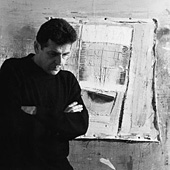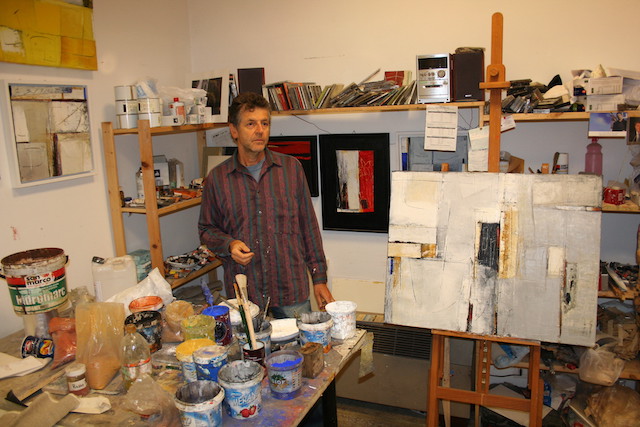Marino Iotti

Marino Iotti was born in Reggio Emilia in 1954, and while still very young he began a pictorial journey that would come to interest such authors as Achille Bonito Oliva, Claudio Cerritelli, Giuseppe Berti, Marinella Paderni, Massimo Mussini and Sandro Parmiggiani. He learned the technical basics by attending courses that Prof. Giulio Soriani held at the Piccola Accademia di Regina Pacis, and later with sculptor Ugo Sterpini.
In 1978 he began his exhibition activity in Scandiano (RE) with “Studio aperto,” a studio/gallery that was intended to be a point of encounter and comparison among artists. Although increasingly fascinated by aniconic painting, Iotti devoted part of the early 1980s to the study of 20th-century Italian painting. He painted numerous portraits with a strong psychological imprint, drawing inspiration from artists such as Casorati, Funi, and Sironi. Study that allows the artist to strengthen his technical skills. But it is with artists such as Graham Sutherland and Giacometti that the gradual shift to a language that is at first symbolic (with themes such as ecology and horror at war) and then shifts to abstract/formal painting takes place.
The incessant search is the datum that characterizes all Marino Iotti’s work; a continuous search, never forced and always becoming, a passionate study of the subtle balances that color and sign can still convey.
In the last decade he began collaborating with Saletta Galaverni in Reggio Emilia, where he presented two solo shows in 2004 and 2009, and with Nickel Gallery in Seebruck, Germany, where he exhibited in 2002 and 2004 plus other group shows.
Other significant exhibitions: in 2002 “Infinite Voci” in the Fortress of Scandiano; in 2005 “Quel nulla di inesauribile segreto” Church of the Madonna in Cast Sotto; in 2007 “Racconti interiori” Spazio Tadini in Milan; in 2008 “Nel segno della Natura” Headquarters of the Stelvio National Park – Prato allo Stelvio (Bz); in 2011 ” Resonances of the Visible” Chiostri di San Domenico Reggio Emilia, “The complexity of the fragment” Galleria Meridiana, Pietrasanta – “Scartches” Galleria Marelia, Bergamo; in 2012, “90 artists for one flag” Chiostri di San Domenico Reggio Emilia, Palazzo Ducale di Modena, Complesso del Vittoriano, Rome 2013; in 2014 Triennale di Roma; Galleria 13, Reggio Emilia.

Marino Iotti in the studio
Painting works in the gallery
20 X 20
Marino Iotti’s poetics is directly linked to the historicized masters of the Italian and international abstract-informal movement, yet finds its own originality imbued with lyricism and musicality. Music in fact is the leading motif of an authentic “making painting,” which takes its cue from the surrounding landscape and reworks it with thought. A mode played on the stratifications of wood, matter, painted fabrics that go to assemble in geometric compositions and pieces of color, showing an excellent compositional balance. Paintings like “notebooks,” like notes taken from life in everyday life, sketches imprinted on canvas that go on to compose day after day the finished work in the painter’s studio.
In 1994, Gallery 13 proposed that modern painter Franco Rognoni exclusively create oil paintings in a 20x20cm format. The idea, in contrast to the widespread tendency to make larger and larger works, wanted to address the issue of the lack of space in small middle-class living rooms, and at the same time, demonstrate that it was possible to make works of great quality and refinement even in small sizes, which is actually not easy.
The problem of space is still a topical issue, so it was decided to pose this challenge again, but in a contemporary key, to the painter Marino Iotti, who made fifty “20×20” paintings for us.
These small masterpieces have been collected in a catalog raisonné, with critical text by Sandro Parmiggiani, printed in 500 numbered copies.
Critical texts
Resonance of the visible
About Marino Iotti’s pictorial journey
by Claudio Cerritelli
Scraps of memory in the form of a landscape, this is how we could call these multi-material joints by Marino Iotti, obtained through the pictorial qualities of the materials of which they are made, splinters of various origins compressed in a geometrical arrangement where shape and shapeless are in balance.
The image of the landscape is a tangible stratification of fragments organized along lines of delimitation between sign and color, every rule of construction does not deny the emotion of painting but enhances the balance between the structural intelligence of space and freedom of pictorial gesture.
As he joins the materials, the artist suggests sharp glimmers and breaths of emptiness, cracks and joints between one piece and the next, with slightly oblique patterns that can be traced back to a basic orthogonality.
The landscape is articulated between calibrated measures and divergent orientations, through imperceptible deviations that range from the smallest detail to the maximum expansion of the composition. The insertion of materials into the pictorial field causes minimal tensions that change the moods and rhythms of the landscape, landscape painting – let’s be clear – which is a different concept from the conventional genre of “landscape painting”. Iotti is well aware that it is not so much a matter of observing the landscape as of living it as an active material in its internal mechanisms, not only a formal but an existential development, without excluding the poetic dimension of meditation such as thought on the precariousness of time.
In the process of manipulating matter unforeseeable events arise, the layers join on the edge of instinct, unstable horizons are suspended between the orthogonal and the oblique, like large maps where the eye moves towards thresholds of disconnection.
In order to comprehend the landscapes in their complex articulation, it is necessary to verify every minimum variation, as each work seems to be part of a sequence that – especially in this last creative season – takes on the character of a real work programme.
Alongside the wisdom of the pictorial instinct, the ability to treat the pieces, to choose them for their chromatic quality, transforming a banal material into a different identity, into something attractive and necessary for the stratified horizon of the landscape, should not be underestimated. Old salvaged woods,
fragments of hemp and raw canvas, damask fabrics for upholsterers, handmade papers, old posters, empty, cut and open tubes of colour, pigments and graphs, pieces of leather: these are the materials that attract the artist’s imagination according to the pictorial yield, quantity and quality intimately connected
in a single process.
The overlapping of materials and their contamination is never harsh, the material pieces are brought together through subtle chords, the tactile inserts are used only when they are truly assimilable in the body of the scenery In addition, there is a sensitive way of using the scratchy signs as further connections
between the objects and the pigments, as in the case of scalings and abrasions that reveal the desire for the primordial, the search for the primary values that painting needs during the final assembly of the landscape. The expertise of the pictorial operation produces a vision interwoven with shapes that reflects each other, different substances that express their cohesion, combinations that have the gift of lightening the weight of materials by communicating a mental reality through the sources of physicality.
This patient work involves an accumulation of energy that the project of each work holds within its particular spatial organism, synthesis of a language that lives on autonomous and rigorous two-dimensionality, emblematic surface where the painting is alone in front of itself, focused on the mental and lyrical reality of its appearances. In fact, the surface is for Iotti the supreme place to measure the breath of thought, to test the gesture that breaks and recomposes signs and colors as notes of an existential journey, a journey in the journey that contains promises of future changes, other textures of the landscape, concrete places of fantasy, new resonances of the visible.
From the catalog “Natural Silences”
by Achille Bonito Oliva, 2013
Talking about silence is a bit like violating it, but sometimes putting one’s interiority in front of words, with shrewd delicacy to arouse desire, often repressed, is also the way to give breath to one’s soul beyond the narrow and agitated everyday realms, toward great horizons that evoke Nature, the infinite.
Modern culture tends to persuade us that we can know everything and dominate everything. Human reason seems to have lost its sense of its own measure and has somehow contaminated with its claim to omnipotence even the sphere of visual arts, where the presence of Mystery is less and less experienced and welcomed.
It is precisely the inner Silence that can dilate the soul to the point of making it capable of welcoming the silence of Nature and all those places of the soul that bring us back to it. The formal decomposition in Marino Iotti’s works is never violent. In his blunt and light geometries in the choice of elegant tones sometimes veiled and transparent that allow a glimpse of rougher signs. In this play of colors lines and shapes seem to emerge primitive anthropomorphic figures, sometimes ancestral graffiti. These works continue an original research in the fascinating dimension of informal.
